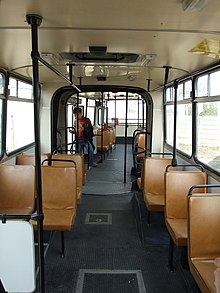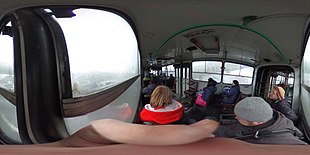This article has multiple issues. Please help
improve it or discuss these issues on the
talk page. (
Learn how and when to remove these template messages)
|
| Ikarus 280 | |
|---|---|
 Preserved Ikarus 280 at the Public Transport Museum,
Prague in September 2013 | |
| Overview | |
| Manufacturer | Ikarus |
| Body and chassis | |
| Doors | 2 (Ikarus 280.10) to 4 (Ikarus 280.08) |
| Floor type | High-floor |
| Chassis | Semi-self-supporting with frame, inspired by VöV-1 design |
| Related |
Ikarus 256 Ikarus 260 Ikarus 293 Ikarus C80 |
| Powertrain | |
| Engine | Straight-six Diesel engines:
|
| Capacity | 93-160, depending on the door formula and seating arrangement |
| Power output | 141–184 kW (189–247 hp) |
| Transmission |
Csepel
ZF 6-speed
manual Csepel HAFO 6-speed
manual Voith DIWA ZF Ecomat 4HP and 5HP |
| Dimensions | |
| Length | 16,500 mm (54 ft 1+5⁄8 in) |
| Width | 2,500 mm (8 ft 2+3⁄8 in) |
| Height | 3,165 mm (10 ft 4+5⁄8 in) |
| Curb weight | 12,580 kg (27,730 lb) |
| Chronology | |
| Predecessor | Ikarus 180 |
| Successor | Ikarus 435 |

Ikarus 280 was an articulated bus produced by Hungarian bus manufacturer Ikarus from 1973 to 2002. [1] It was succeeded by the Ikarus 435 in 1985.
Construction features
The Ikarus 280 is a model of the Ikarus 200 series. It is made of two rigid sections linked by a pivoting joint. The body is a semi-self-supporting body with a frame, the Raba-MAN D2156 inline-6 diesel engine is mounted in the front section. [a] It powers the middle axle, meaning that the bus has puller configuration. All three axles are air-sprung beam axles with additional telescopic shock absorbers. Both rear and middle axles were made by Rába, while the front axle was made by LiAZ. [b] Either an automatic or a manual gearbox was installed that allowed a top speed of 65 to 90 kilometres per hour (40 to 56 mph). The manual gearboxes came in either five- or six-speed configuration, and were mated with a dry single-disc clutch. The Ikarus 280 has a pneumatic braking system, a spring loaded parking brake, and an exhaust brake. The steering is hydraulically assisted. [2] The buses, in actual applications, have a minimum of 26 seats, and space for up to 134 additional standing passengers. [c]
Production and operation
Production started in 1973 and ended in 2002. The 280 was based on the Ikarus 200 platform and had many variants produced. Currently (2020), the number of Ikarus 280 buses in active service is declining, due to supply of new low-floor buses. The articulated buses 281(RHD), 282 and 283 (18 m (59 ft)-versions), 284 (pusher configuration), C80, C83, the articulated trolleybuses Ikarus 280T, 283T, 284T and the double articulated Ikarus 293 were based on the Ikarus 280.

( view as a 360° interactive panorama)
Ikarus C80
Ikarus C80 is a limited-run reproduction of Ikarus 280 in the 2000s. It is slightly different from the original Ikarus 280 in a few regards. All are used by Hungarian company Volanbusz.
| Ikarus C80 subtypes | |||||||
|---|---|---|---|---|---|---|---|
| Subtype | Engine | Gearbox | |||||
| C80.30A | Rába D10 UTSLL | ZF 4HP 500/Voith-Diwa 851.3 | |||||
| C80.30M | Rába D10 UTSLL | ZF S6-120U | |||||
| C80.33 | Rába D10 UTSLL | ZF S6-120U/ZF 4HP 500/Voith-Diwa 851.3 | |||||
| C80.40A | Rába D10 UTSLL | ZF 4HP 500/Voith-Diwa 851.3 | |||||
| C80.40M | Rába D10 UTSLL | ZF S6-120U | |||||
See also
Notes
References
- ^ "Фото: Таджикистан, № 0171 ТТ 01 — Ikarus 280.33O — Фотобус". fotobus.msk.ru. Retrieved 15 October 2016.
- ^ Oswald, Werner (ed.): Kraftfahrzeuge der DDR, (2nd ed.), Motorbuch-Verlag, Stuttgart 2000, ISBN 3-613-01913-2, p. 315 (in German)